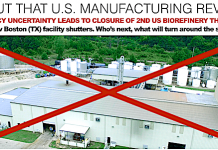Jim Lane
Two giants hook up to bring cellulosic biodiesel to scale. A new source of biodiesel feedstock, and a new source of renewable fuels.
In Iowa, ExxonMobil (XOM) and Renewable Energy Group (REGI) have agreed to jointly study the production of biodiesel by fermenting renewable cellulosic sugars from sources such as agricultural waste.
REG has developed a patented technology that uses microbes to convert sugars to biodiesel in a one-step fermentation process similar to ethanol manufacturing. The ExxonMobil and REG Life Sciences research will focus on using sugars from non-food sources. Terms were not disclosed.
Readers will remember the technology unit, branded as LS9 before the REG acquisition in 2014. LS9 focused on biodiesel from its earliest days in 2006 in fact, that was the sole product in development until a detergent alcohol was put into development in 2008.
“The core technology is advanced”
Through the research, the two companies said they will address the challenge of how to ferment real-world renewable cellulosic sugars, which contain multiple types of sugars, including glucose and xylose, but also impurities that can inhibit fermentation.
“The core biodiesel technology is advanced,” REG Vice Presdient Eric Bowen told The Digest. “That’s one of the reasons ExxonMobil reached out, they know there’s a quicker timelines than other projects they’ve looked at, because there’s 7 years of work already done to ferment sugars into FAME biodiesel. The work now is to port that technology to cellulosic sugars, something which there has been DOE-sponsored work on in the past, some of which was announced publicly.”
“The bulk of cellulosic sugars development has been for cellulosic ethanol, which is primarily though not exclusively a yeast-based fermentation. It’s much more dilute, too. In our work, we do very concentrated fermentations and we like a very concentrated sugar source. So, optimizing those sugar streams, and understanding the impurities is an important part f the work going on now. The impurities depend on the source. They could include acids from the hydrolysis, or ash content. We’ll be looking at how concentrated those impurities are.”
“If there were large volumes of sugars available today, I have no doubt we could manufacture almost right away.”
ExxonMobil’s interest?
Exxon has been quiet of late in renewables, though they ran some algae TV ads around the time of COP 21. Maybe, in the context of showing that they are “doing something”. Lately, they’ve been more active in partnering and talking up their algae research. Consider this $1 million partnership with Michigan State University, here , or this recent ExxonMobil perspectives posting, here.
Back in the days before REG acquired LS9 and before the cellulosic sugar path was discovered, Chevron became an investor in 2009. Back then, the aim was to show that it could produce renewable diesel at $45-50 per barrel, by 2011, with a goal of commercial-scale production as soon as 2013. The basic science, said LS9 at the time, was completed it was a matter of yield and scale.
Timing?
“The timing is really about the availability of cellulosic sugars,” Bowen added. “If there were large volumes of sugars available today, I have no doubt we could manufacture almost right away. The technology has been significantly de-risked.
“Clearly, our interest and ExxonMobil’s is on commercial-scale production,” Bowen said. “There’s a stage-gate process in place.
The pivot to cellulosic feedstocks
On LS9’s fuel aspirations we wrote some time back:
Given that there are seven pounds of oil to a gallon, the cost of US sugar makes fuel production completely out of the question for now, and will push bioprocessors towards the higher-end chemical and bio-based products for the near term. In the company’s early days, the magic bug lived on corn or cane syrups – and for that reason the company was initially expected to build its first commercial facility in Brazil, the Saudi Arabia of cane syrup.
But, no longer.
That’s where Jay Keasling’s lab at UC Berkeley/JBEI comes into the picture. In early 2010, working with REG Life Sciences, they came up with a way to utilize cellulosic sugars. At the time, they said that the team of researchers engineered a microbe that “consolidates advanced biofuels production and cellulosic bioprocessing for the first time. This breakthrough enables the production of advanced hydrocarbon fuels and chemicals in a single fermentation process that does not require additional chemical transformations.” The research results appeared in the January 28, 2010 edition of Nature.
The cellulosic option broadened the geography considerably conceptually, into REG’s base of operations in the Midwestern US. Or, possibly in its new operating sphere of Eastern Europe.
Advanced fuels, good, advantaged fuels, better
Biodiesel is America’s favorite advanced biofuel, but it also is one of the most advantaged by policy considerations. Specifically, biodiesel qualifies under the Renewable Fuel Standard as a biomass-based diesel fuel; it qualifies for the biodiesel tax credit, if that is extended beyond 2016; it conceivably qualifies under RFS relating to the sale of cellulosic waiver credits, as a cellulosic fuel. If produced in California, it would qualify under the California Low Carbon Fuel Standard.
Bowen agrees. “Cellulosic RINs? There’s that nested category, cellulosic diesel, that was established for some players that aren’t around any more, but it’s there, and although we have not completed the lifecycle analysis and not yet formally approached EPA, we’re expecting that the fuels would not only qualify as an advanced biofuels but as a cellulosic diesel. California would welcome this fuel, I would expect, and we expect it to fit the Low Carbon Fuel Standard very well, though again, the lifecycle analysis has yet to be completed.
What about cellulosic drop-in fuels?
Well, REG Life Sciences has IP in that area too. In the article “Microbial Biosynthesis of Alkanes” published in Science magazine in July 2010, a team of REG LS scientists announced the discovery of novel genes that, when expressed in E.coli, produce alkanes, the primary hydrocarbon components of gasoline, diesel and jet fuel. This discovery is the first description of the genes responsible for alkane biosynthesis and the first example of a single step conversion of sugar to fuel‐grade alkanes by an engineered microorganism.
Yield, and scale-up
Scale? That’s something for later in the partnership, as the partners have indicated. So, we are left with the chase for yield. It’s the task that consumes Amyris (AMRS) every day, Yield, yield, yield.
No more so than with cellulosics, where the sugars are only a fraction of the biomass and the transportation and logistics penalties for low yields add up quickly.
“Right now, as with all our process development, we’re focused on the 5 liter stage now,” REG’s Bowen told The Digest, “and then it moves to the 650-liter stage, and then as with all our work it would move to Okeechobee for testing in large scale fermenters.”
ExxonMobil’s reaction
“This research is just one way ExxonMobil is working to identify potential breakthrough technologies to reduce greenhouse gas emissions, increase energy supplies and realize other environmental benefits,” said Vijay Swarup, vice president of research and development at ExxonMobil Research and Engineering Co
mpany. “The science is extremely complex, but we hope to identify new affordable and reliable supplies of energy for the world that do not have a major impact on food supplies.”
“As we research renewable energy supplies, we are exploring future energy options with a reduced environmental impact,” Swarup said. “Our first challenge is to determine technical feasibility and potential environmental benefits during the initial research. If the results are positive, we can then take the next step and explore the potential to expand our efforts and explore scalability.”
The REG Life Sciences demonstration plant
REG Life Sciences’s demonstration plant is in Okeechobee, Florida, and was initially designed, and has been used, to scale-up LS9’s fermentation technology and generate large commercial samples for testing and product qualification by key partners and prospective customers. Since the company’s initial run at 135,000 liter scale in Q3 2012, LS9 has made numerous additional fatty alcohol runs, production runs of fatty acid methyl esters (biodiesel), and some co-operative work with Cobalt Technologies.
In 2012, we wrote of LS9’s demonstration plant opening day.
In the glades north of Lake Okeechobee, in rural Florida, a 135,000 liter fermenter column stands out against the landscape like Salisbury Cathedral rising over the plains of Thomas Hardy’s Wessex, and you half expect a tropically-attired Tess of the D’Urbervilles to come around the corner at any moment.
But the VIP-filled sedans, kicking up dust as they head northwest from the lake, are greeted primarily by dumbfounded cows and bulls that are still wondering, to the extent that they wonder, how yellow dragon disease took the citrus trees away, and where all the workers went in Okeechobee County, why so many Family Dollar thrift shops have popped up, and why so many people are using boards in place of window glass.
After all, the cows see all the Mercedes sweeping from the rich coastal enclaves like Jupiter and Palm Beach, en route to one of the several appealing hunting clubs that dot the region, or the golf courses of the west side.
Do they wonder how the rich got so rich, and the poor so poor, in such a hurry, down in Florida? To the extent that bulls consider macroeconomics, in between meals in the pasture as the cars go by.
The opening of that fermenter column is what the VIPs are coming to celebrate, because LS9’s demonstration facility opened for business in Okeechobee yesterday. A wonder of science it is – a technology that takes in sugars, and through microbial fermentation directly converts the material into a programmable array of products, including biodiesel, jet fuel, diesel, or surfactant alcohols, just for starters.
The Bottom Line
Well, ExxonMobil. REG. Biodiesel and its established market, and legion of fans. The “we could manufacture almost right away” perspective from REG. What’s not to like about this one? It’s a pick-me up of the first magnitude, and coming on the heels of the US Navy, Tesoro, and Suntory in recent days it’s a tidal wave of dive-ins by major partners, for sure.
Jim Lane is editor and publisher of Biofuels Digest where this article was originally published. Biofuels Digest is the most widely read Biofuels daily read by 14,000+ organizations. Subscribe here.







